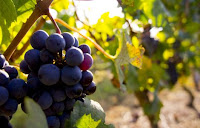BURGUNDY CYCLING TOURS DETOURS IN FRANCE
We would be pleased to help you to organize your Burgundy Cycling Tours
Beaune
Côte de Beaune
"The Chardonnay's Kingdom" vines from Chassagne Montrachet, Puligny Montrachet and Meursault
The Côte de Beaune area is the southern part of the Côte d'Or, the limestone ridge that is home to the great names ofBurgundy wine. The Côte de Beaune starts between Nuits-Saint-Georges and Beaune, and extends southwards for about 25 km to the River Dheune. The trend of producing red wines continues from the Côte de Nuits to the north, down through Beaune, although the wines become lighter and more perfumed. Farther south lie the great names of white Burgundy such as Meursault and Chassagne-Montrachet. The far south of the district sees a return to red wines in Santenay that continues across the Dheune into the Côte Chalonnaise. This mix of Pinot noir and Chardonnay grapes reflects geology in the southern Côte d'Or that is more variable than in the north.
Côte de Nuits
The Côte de Nuits is a French wine region located in the northern part of the Côte d'Or, the limestone ridge that is at the heart of the Burgundy wineregion. It extends from Dijon to just south of Nuits-Saint-Georges, which gives its name to the district and is the regional center. Though some white and rosé wines are produced in the region, the Côte de Nuits is most famous for reds made from pinot noir. The Côte de Nuits covers fourteen communes. Six produce grand cru wines, in the central district between Gevrey-Chambertin and Nuits-Saint-Georges, with four lesser villages either side. The Grand Crus of the Cote de Nuits are some of the smallest appellations in France, less than a hectare in the case ofLa Romanée.[1][2]
Among the northern villages of the Côte de Nuits there are several distinct terroir. Uniquely in Burgundy, Marsannay-la-Côte produces wine of all three colors - red and rosé from Pinot Noir, white from Chardonnay. The 529 acres (214 ha) of the Marsannay appellation extends intoCouchey and Chênove. The village of Fixin has its own appellation, but the area of BrochonCôte de Nuits Villages extends into the commune with 55 acres (22 ha) of premier cru vineyards out of 193 acres (78 ha) of Pinot Noir and 3 acres (1.2 ha) of Chardonnay. The village of Gevrey-Chambertin has more Grand Crus than any other village, with nine. Chambertin and its extension Chambertin-Clos de Beze are widely recognized for the quality of their red Burgundy. The other Grand Crus are Mazis-Chambertin, Chapelle-Chambertin, Charmes-Chambertin,Mazoyeres-Chambertin, Griotte-Chambertin, Latricieres-Chambertin and Ruchottes-Chambertin.Morey-Saint-Denis is a small commune with four Grand Crus: Clos de la Roche, Clos St. Denis,Clos des Lambrays and Clos de Tart.[3][4]
Also among the northern villages, the vineyard soils of Chambolle are particularly chalky, giving the wines a lighter body and finer edge of aromas that complements the usual Côte de Nuits backbone of flavor notes. A little white wine is also made in this area. Wines labelled with Chambolle Premier Cru are usually a blend of some of the 19 individual vineyard Premier Crus, of which only Les Amoureuses and Les Charmes are commonly seen. The Grand Crus are Bonnes Mares (which spills over into Morey-Saint-Denis) and Musigny. The village of Vougeot has just one Grand Cru vineyard - Clos Vougeot - that is massive by Burgundy standards, and produces three times as much wine as the rest of the commune. But the variation in terroir over its 124 acres (50 ha), and the different winemaking styles of its 75+ owners, mean that wines labeled with the vineyard name Clos Vougeot show as much variation as the wines from entire communes elsewhere. The village of Flagey is best known for its Grand Crus of Grands Echézeaux and Echézeaux; its Premier Crus are sold under the label of Vosne-Romanée. Vosne contains some of the most famous names in the wine world, notably Romanée-Conti and La Tâche, twomonopoles of the Domaine de la Romanée-Conti. The other Grand Crus are Richebourg, La Romanée (the smallest AOC in France, at 2 acres/0.84 hectares),Romanée-St. Vivant and La Grand Rue.[5][6]

The Route des Grands Crus
The route des Grands Crus (roughly, "road of the great wines") is the name of a small vineyard road meandering through villages in Burgundy.
The approximately 60-kilometre route runs along the foot of the Côte d'Or escarpment, from Dijon in the north toSantenay in the south. Thus it runs through many of the great appellations of Burgundy wine, hence the name of the route. It takes the visitor through the vineyards of the Côte de Nuits and the Côte de Beaune and the back hills (Hautes-Côtes) behind and above the wine slopes.
It is punctuated by 33 villages or little towns, including Beaune, many of which have picturesque churches.
From Wikipedia, the free encyclopedia 2016 www.detours-in-france.com





Aucun commentaire:
Enregistrer un commentaire